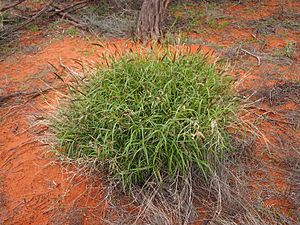Buffel-grass facts for kids
Quick facts for kids Buffel-grass |
|
|---|---|
 |
|
| Conservation status | |
| Scientific classification | |
| Genus: |
Cenchrus
|
| Species: |
ciliaris
|
| Synonyms | |
|
|
Cenchrus ciliaris is a type of grass often called buffel-grass or African foxtail grass. It's also known by names like dhaman grass or anjan grass. This grass originally comes from most of Africa, parts of southern Asia, southern Iran, and a small area in southern Europe (Sicily).
Contents
What Buffel-Grass Looks Like
African foxtail grass is a perennial plant. This means it lives for more than two years. It usually grows to be about 20 to 120 centimeters (8 to 47 inches) tall. Its leaves are long and narrow, typically 3 to 25 centimeters (1 to 10 inches) long and 4 to 10 millimeters (0.16 to 0.39 inches) wide. The flowers grow in a special cluster called a panicle. This panicle can be 2 to 14 centimeters (0.8 to 5.5 inches) long and 1 to 2.6 centimeters (0.4 to 1 inch) wide.
Where Buffel-Grass Grows
Buffel-grass is native to tropical Africa, the Mediterranean area, and the hotter, drier parts of Asia. It has deep roots, which helps it survive during dry times. It can grow at high altitudes, up to 2,000 meters (6,560 feet). Farmers in Africa often use it as a good food source for their animals.
This grass likes light soils that have a lot of phosphorus. It has also been planted in places like Queensland, Australia, to feed livestock and make hay. It was brought to the Sonoran Desert in the United States to help stop soil from washing away and to feed farm animals. In the Mexican part of the Sonoran Desert, people still plant it and water it for grazing animals.
However, buffel-grass has spread and become an invasive species in many places. This means it grows where it's not native and can harm the local environment. You can find it in Australia, the southwestern United States, Hawaii, Mexico, Central America, South America, and Macaronesia.
Why Buffel-Grass Can Be a Problem
Buffel-grass was brought to Arizona, United States, in the 1930s for grazing. While it wasn't very successful for grazing, it started growing as a weed along roads and in cleared fields. It spreads very quickly and can take water away from native plants, sometimes causing them to die.
One big problem with buffel-grass is that it catches fire very easily. It can even burn during its main growing season. This makes wildfires much more intense. For example, saguaro cacti in the Sonoran Desert can usually survive wildfires. But when buffel-grass grows around them, the fires become so hot that the saguaros can burst into flames.
In Queensland, Australia, buffel-grass has caused problems for the critically endangered northern hairy-nosed wombat. It reduces the native grasses these wombats eat, which contributes to their decline. In South Australia, it is considered a declared plant that needs to be managed. Also, in Australia's Northern Territory, buffel-grass made it harder to control wildfires in 2019. These fires destroyed ancient trees in special places like Standley Chasm.
See also
 In Spanish: Cenchrus ciliaris para niños
In Spanish: Cenchrus ciliaris para niños


